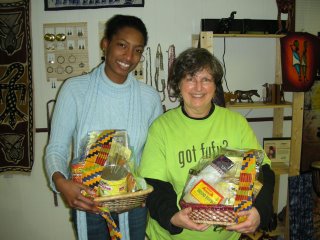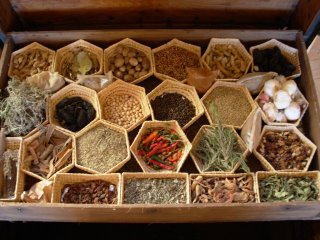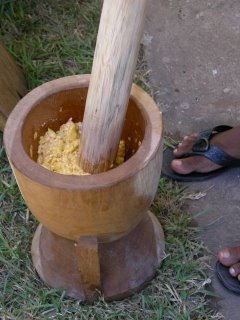Touch of Africa; Spring Class on African Food and Culture
 It's been hectic for me lately. Last Saturday night was Penn State's annual Touch of Africa celebration sponsored by the African Students' Association. As usual, it was a sold-out event (500 tickets) and a cultural extravaganza that gave the students and the community an opportunity to taste unfamiliar foods and experience the music, fashion, story-telling and energy of Africa, largely normally unavailable to central Pennsylvanians. I was brought in late in the game to oversee the preparation of the food with the The Penn Stater's professional cooking staff and some student volunteers. I don't generally do quantity cooking, so it was a challenge, but the team managed to pull it off with help from The Penn Stater's chef Ken Stout and his staff. A few (very few--I was too busy to take pictures) photos from the event are up on my BETUMI account on flickr. The menu included several West African dishes, representing the heavily West African ASA membership (efo stew with greens and beef and smoked fish and smoked ground shrimp and palm oil), egusi (a.k.a agushi,
It's been hectic for me lately. Last Saturday night was Penn State's annual Touch of Africa celebration sponsored by the African Students' Association. As usual, it was a sold-out event (500 tickets) and a cultural extravaganza that gave the students and the community an opportunity to taste unfamiliar foods and experience the music, fashion, story-telling and energy of Africa, largely normally unavailable to central Pennsylvanians. I was brought in late in the game to oversee the preparation of the food with the The Penn Stater's professional cooking staff and some student volunteers. I don't generally do quantity cooking, so it was a challenge, but the team managed to pull it off with help from The Penn Stater's chef Ken Stout and his staff. A few (very few--I was too busy to take pictures) photos from the event are up on my BETUMI account on flickr. The menu included several West African dishes, representing the heavily West African ASA membership (efo stew with greens and beef and smoked fish and smoked ground shrimp and palm oil), egusi (a.k.a agushi,  a fabulous melon seed and one of the so-called "lost crops of Africa") soup, puff puff (a Nigerian doughnut), chicken jollof rice, fried ripe plantains, hot and mild versions of
a fabulous melon seed and one of the so-called "lost crops of Africa") soup, puff puff (a Nigerian doughnut), chicken jollof rice, fried ripe plantains, hot and mild versions of Ghanaian-style tomato gravy, and bissap (hibiscus chilled tea with lemon grass and pineapple juice), as well as North African-style couscous, East African coconut basmati rice and Somali sombosas, roasted chicken, tilapia with sauce, and all-Africa tropical fruit salad with flaked coconut.
Ghanaian-style tomato gravy, and bissap (hibiscus chilled tea with lemon grass and pineapple juice), as well as North African-style couscous, East African coconut basmati rice and Somali sombosas, roasted chicken, tilapia with sauce, and all-Africa tropical fruit salad with flaked coconut.
Sore Shields of The African Market and I coordinated a silent auction to raise money for 2 charities in Africa, and Kunmi Oluleye of Flavors of Africa generously donated copies of her cooking dvd of Nigerian, Kenyan, and South African cooking (first in a series of 17 planned). Thank you to everyone who helped and bid on the items.
Now, I need to get ready to teach a five-week African cooking (and culture) course beginning March 18. . . Never a dull moment.
Labels: african cuisine, African Students Association, Penn State, Shields, touch of africa



